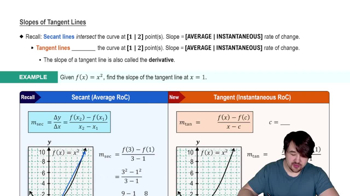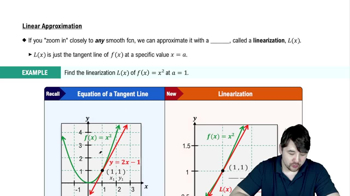Table of contents
- 0. Functions7h 52m
- Introduction to Functions16m
- Piecewise Functions10m
- Properties of Functions9m
- Common Functions1h 8m
- Transformations5m
- Combining Functions27m
- Exponent rules32m
- Exponential Functions28m
- Logarithmic Functions24m
- Properties of Logarithms34m
- Exponential & Logarithmic Equations35m
- Introduction to Trigonometric Functions38m
- Graphs of Trigonometric Functions44m
- Trigonometric Identities47m
- Inverse Trigonometric Functions48m
- 1. Limits and Continuity2h 2m
- 2. Intro to Derivatives1h 33m
- 3. Techniques of Differentiation3h 18m
- 4. Applications of Derivatives2h 38m
- 5. Graphical Applications of Derivatives6h 2m
- 6. Derivatives of Inverse, Exponential, & Logarithmic Functions2h 37m
- 7. Antiderivatives & Indefinite Integrals1h 26m
- 8. Definite Integrals4h 44m
- 9. Graphical Applications of Integrals2h 27m
- 10. Physics Applications of Integrals 2h 22m
4. Applications of Derivatives
Linearization
Problem 4.6.6
Textbook Question
Suppose f is differentiable on (-∞,∞) and the equation of the line tangent to the graph of f at x = 2 is y = 5x -3. Use the linear approximation to f at x = 2 to approximate f(2.01).
 Verified step by step guidance
Verified step by step guidance1
Identify that the tangent line equation y = 5x - 3 provides the slope of the tangent line, which is the derivative of f at x = 2. Therefore, f'(2) = 5.
Recognize that the linear approximation formula is f(x) ≈ f(a) + f'(a)(x - a), where a is the point of tangency, which in this case is x = 2.
Substitute the known values into the linear approximation formula: f(2.01) ≈ f(2) + f'(2)(2.01 - 2).
Use the tangent line equation to find f(2). Since the tangent line passes through the point (2, f(2)), substitute x = 2 into y = 5x - 3 to find f(2).
Calculate the approximation using the values obtained: f(2.01) ≈ f(2) + 5(0.01).
 Verified video answer for a similar problem:
Verified video answer for a similar problem:This video solution was recommended by our tutors as helpful for the problem above
Video duration:
3mPlay a video:
Was this helpful?
Key Concepts
Here are the essential concepts you must grasp in order to answer the question correctly.
Differentiability
A function is differentiable at a point if it has a defined derivative at that point, meaning it has a tangent line. This implies that the function is continuous and smooth around that point. Differentiability is crucial for understanding how functions behave locally and is foundational for concepts like linear approximation.
Recommended video:

Finding Differentials
Tangent Line
The tangent line to a function at a given point represents the best linear approximation of the function near that point. It is defined by the slope, which is the derivative at that point, and the point of tangency. In this case, the tangent line at x = 2 is given by the equation y = 5x - 3, indicating that the slope is 5.
Recommended video:

Slopes of Tangent Lines
Linear Approximation
Linear approximation uses the tangent line to estimate the value of a function near a specific point. The formula for linear approximation is f(x) ≈ f(a) + f'(a)(x - a), where a is the point of tangency. This method allows us to approximate f(2.01) using the known values of f(2) and its derivative at that point.
Recommended video:

Linearization
Related Videos
Related Practice



